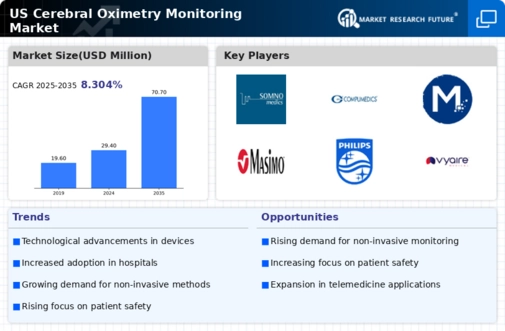The US Cerebral Oximetry Monitoring Market is characterized by a dynamic competitive landscape that involves several prominent players vying for market share through innovation and enhanced product offerings. The increasing demand for cerebral oximetry monitoring in critical care settings, surgical environments, and patient monitoring solutions has driven companies to develop advanced technologies that provide reliable and non-invasive measures of cerebral oxygen saturation.
As healthcare institutions prioritize patient outcomes and safety, the competition among vendors intensifies, leading to efforts in research and development, collaborations, and strategic partnerships aimed at expanding product lines and capabilities. Furthermore, advancements in sensor technology and the integration of cerebral oximetry with other monitoring modalities play crucial roles in influencing market dynamics and shaping competitiveness.
Nonin Medical has established a significant presence in the US Cerebral Oximetry Monitoring Market, known for its focus on innovation and quality. The company specializes in non-invasive monitoring solutions, with a robust product portfolio that emphasizes reliability and accuracy in patient care. Nonin Medical's strengths lie in its commitment to research and development, resulting in advanced monitoring technology that meets the specific needs of healthcare providers. Its extensive distribution network and established relationships with healthcare institutions in the US further enhance its competitive advantage, allowing for effective penetration of the market.
By consistently delivering state-of-the-art products that ensure improved patient outcomes, Nonin Medical solidifies its position in the cerebral oximetry landscape.
Medtronic holds a prominent position in the US Cerebral Oximetry Monitoring Market, recognized for its comprehensive range of medical devices and monitoring solutions. The company offers key products that incorporate cutting-edge cerebral oximetry technology, aiming to deliver precise measurements that assist clinicians in making informed decisions. Medtronic's strengths include its expansive market presence, bolstered by strategic partnerships and collaborations that enhance product distribution and innovation. The company continually invests in research and development, ensuring that its offerings remain at the forefront of technological advancements.
Furthermore, Medtronic's adeptness at mergers and acquisitions enables it to broaden its product portfolio and strengthen its competitive positioning within the US market, allowing the company to respond effectively to the evolving needs of healthcare providers and patients alike.

















